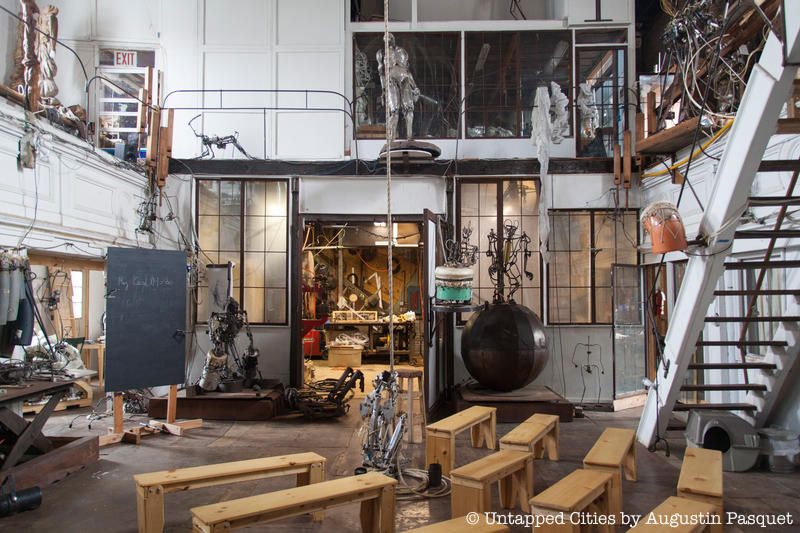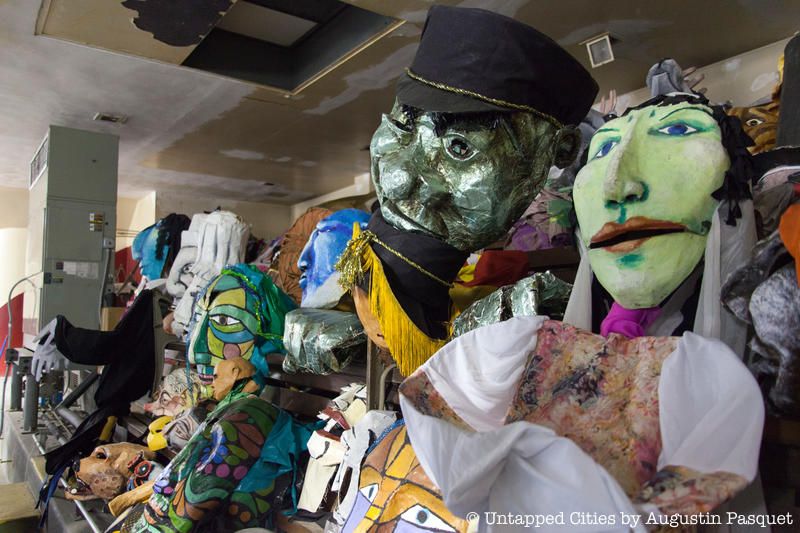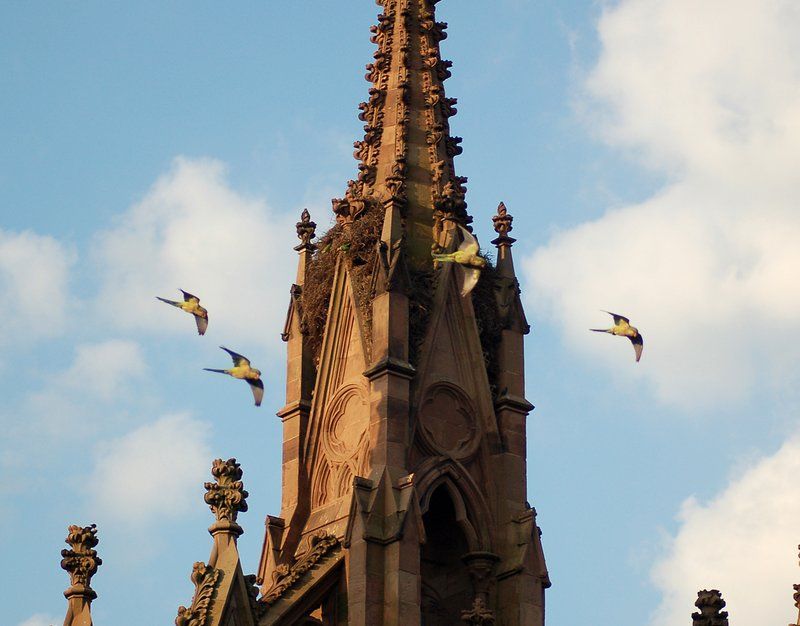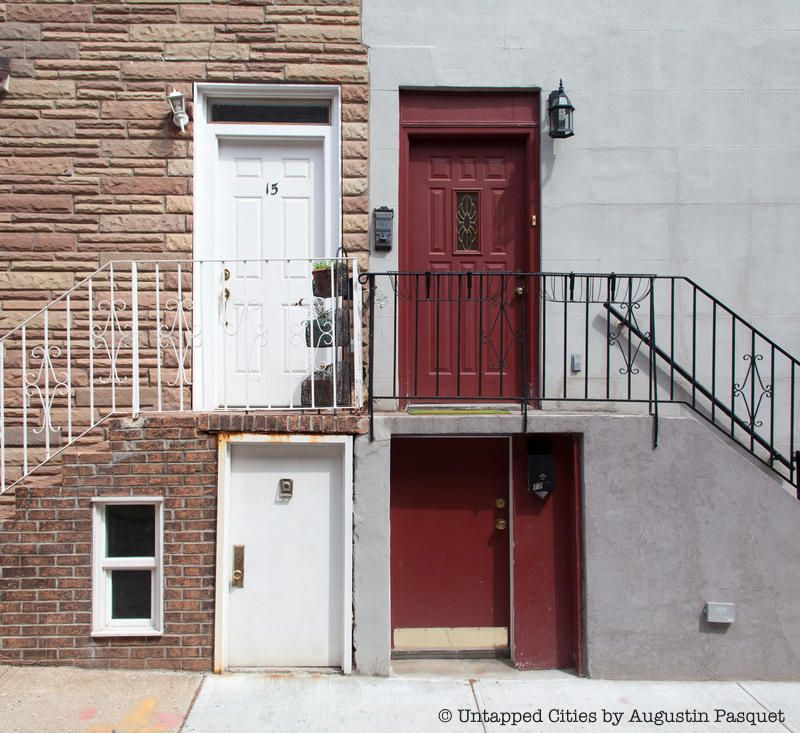✨You Can Touch the Times Square New Year's Eve Ball!
Find out how you can take home a piece of the old New Year's Eve ball!



Officially releasing on July 15th, the book Secret Brooklyn: An Unusual Guide is written and photographed by Untapped Cities founder Michelle Young and co-founder Augustin Pasquet. In anticipation, they’ve selected ten of the weirdest locations they came across in Brooklyn which highlight the diversity of places to discover, the people who make the borough great, and the architecture and infrastructure that keep things fascinating.
You can get an autographed copy directly from Untapped Cities (shipped to you or picked up from our Brooklyn office) or a non-autographed copy on Amazon.

Located in a very tucked away spot in the Roosevelt House at Brooklyn College, The Puppet Library features over 100 puppets, some as large as 20 feet tall, that sit on the bleachers of a gymnasium. The sight alone is rather astounding and worth the trip. These large-scale puppets have appeared in parades, in movies, even birthday parties. You can crawl into the puppets, or even take one out on a loan.
The Puppet Library has been located here since 2008, in a space run by the Brooklyn College Community Partnership, an after school program but the Puppet Library itself does not have a website or a phone number. And it seems that no matter where it has been, The Puppet Library always finds itself in a rather hidden spot. Until 2008, the museum was housed inside the Soldiers’ and Sailors’ Arch at Grand Army Plaza, a place the Puppet Museum librarian Theresa Linnihan says was “a mysterious place. People never knew you could go inside.” There was a spiral staircase inside and visitors could wander freely to take in the museum. Puppet shows would take place at the top of the arch interior. But when the arch started leaking and the roof fell in, the museum needed to find a new home – one big enough to house the collection.
The Puppet Library began in Boston, where it “sort of drifted into experience,” says founder Sara Peattie, a puppeteer by training. Her partner George was living in New York City so the collection started to take hold there. When George died, Linnihan took over the library. She happened on the arch and fought to get the library in there.

The militia of the 14th Regiment once used an extensive, multi-level shooting gallery below the Park Slope Armory. The waiting room is an incredible sight to behold – green-tinged, tin walls and ceilings, with wraparound wooden benches. There was once a wooden railing in the space that is now located on the second floor of the armory, dividing the shelter from the rest of the building.
A narrow hallway from the waiting room leads down to the shooting galleries, which were housed in barrel-vault spaces. Staircases led down to half floors from which the targets would be raised from but portions of the floors have collapsed.
There were two galleries – one for short range hand guns and one for longer range shooting. The galleries are now pitch black, with the only light emerging from the hallways.
You can still see bullet holes in the metal at the end of the firing range. The lower levels of the armory used to also contain horse stables, and possibly a bowling alley. The armory also contains a secret Veterans Museum, another entry in the guide book.
You can get an autographed copy directly from Untapped Cities (shipped to you or picked up from our Brooklyn office) or a non-autographed copy on Amazon.

Image courtesy Brooklyn Parrots
The tale of the wild Brooklyn parrot, one of the most surprising finds in the borough, begins in Argentina. The bright green sub-tropical birds go by a few names – the Quaker Parrot, the Monk Parakeet or its Latin name Myiopsitta monachus – and have been in New York for over 40 years. Considered a pest to farmers in Argentina, the Quaker Parrot survived first an attempt at extermination in its home country, then an exportation scheme as exotic birds to the United States, whereupon flocks made their escape from shipping containers, pet stores and owners.
The best way to see the parrots is through a monthly free tour run by Steven Baldwin, who estimates there are 150 Quaker Parrots in Brooklyn today. He does these “safaris” for awareness, hoping that the more people know about these parrots, the more they will see them as “part of the gorgeous mosaic of Brooklyn.” To prevent poachers, who have come to capture the birds, he tells guests to keep the location secret. “I like to spread the word one by one,” he says.
Though the parrots are more famous for roosting in Green-Wood Cemetery, the location where you can see the parrots most up-close is on a leafy residential street in Flatbush. The birds relocated here after changes were made to the landscape at their previous residence at Brooklyn College (though you can still see some nests in the lights above the athletic field).
Neighbors have taken to the parrots and protect the birds by allowing for the creative nests to grow in street trees. Used to the four seasons, the Quaker Parrots stay in New York City all year round. Baldwin gives tours on the first Saturday of every month, alternating between Flatbush and Green-Wood Cemetery.
You can get an autographed copy directly from Untapped Cities (shipped to you or picked up from our Brooklyn office) or a non-autographed copy on Amazon.

Strolling past the row of houses on Joralemon Street in beautiful Brooklyn Heights, you might notice that something is a little off. Take a close look at the red brick brownstone at number 58; the windows, you’ll see, are completely black. Suspicious, isn’t it? As it turns out, building number 58 is not what it seems; it is a fake brownstone, behind which lies a hidden subway ventilator. It also functions as a emergency exit.
According to the Brooklyn Daily Eagle, “the exit disguised as a brownstone leads to a grimy-lit set of metal stairs that ascend past utility boxes and ventilation shafts into a windowless room with a door. If you opened the door, you would find yourself on a stoop, which is just part of the façade.” Brooklyn Magazine also wrote that the “cavernous interior once housed a battery of electrical devices that converted alternating current to the 600-volt direct current needed to power the IRT.”
You can get an autographed copy directly from Untapped Cities (shipped to you or picked up from our Brooklyn office) or a non-autographed copy on Amazon.

On December 16, 1960, a United Airlines DC-8 and a TWA Super Constellation, collided over Staten Island. The TWA plane would crash on the southern coast of Staten Island, and the United Airlines plane would go down on Sterling Place in Park Slope. It was the deadliest air accident to date at the time with a total death toll of 134 people. It would also be the first accident to be investigated using the infamous “black box.”
Today, the scars of the 1960 plane crash have been mostly repaired, erased or built over, but there are several remnants you can still find today. Read more about them here.
You can get an autographed copy directly from Untapped Cities (shipped to you or picked up from our Brooklyn office) or a non-autographed copy on Amazon.

Truly a secret gem, there’s nothing at street level to suggest that there’s an incredible site-specific installation and workshop inside this former Norwegian Seamans Church in Red Hook. Metal gates are perpetually rolled down on this brick building that dates to the 1880s. Only a doorbell next to the locked alley door gives some clue: it says “Amorphic Robotic Works”.
The Robotic Church is open for performances a few times a year – the rest of the time it functions as the workshop for Amorphic Robotic Works, a collective of artists, engineers, technicians and programmers founded by Chico MacMurtie in 1991. MacMurtie is acclaimed for his large-scale, kinetic sculptures and was most recently awarded a Guggenheim fellowship for the construction of inflatable bridges that can reach across the United States-Mexico border.
While inflatables are the evolution of MacMurtie’s exploration in kinetic mechanical movement, the pneumatic robots are the origin. In the Robotic Church, fifty “humanoid performers” are positioned throughout the former church nave. There’s a control tower up top, through which MacMurtie can lead the performance. A clocking mechanism sets the timing of the performance (usually between 40 and 60 minutes) and the robots communicate through rhythm using body language and sound.
The robots range in size from 12 inches to 15 feet. They’re located on multiple levels of the church, a deliberate reference to the placement of religious saints in a chapel. One robot, attached to a rope, is imbued with the objective to reach the top. Guests sit on wooden benches, “as if coming to church,” MacMurtie describes.
You can get an autographed copy directly from Untapped Cities (shipped to you or picked up from our Brooklyn office) or a non-autographed copy on Amazon.

Just next door to the popular beer hall Berg’n, in an 1850s-era tunnel under the former Nassau Brewery, cheese is aging thirty feet underground. Opened in 2014, Crown Finish Caves is a licensed New York State dairy plant aging cheeses from places near and far. There are cheeses from the Hudson Valley, Vermont, Wisconsin, even Italy. The tunnels, which can be visited during special events, were originally excavated to age lager beer, but the brewery closed in 1914.
The tunnel that Crown Finish Caves currently uses can hold 22,000 pounds of cheese, amidst a state-of-the-art renovation that keeps temperatures at about 50 degrees Fahrenheit and humidity at optimal levels. Crown Finish Caves ages the cheeses using the process of affinage, an old practice that involves dozens of steps to get each cheese to its most perfect state.
The young cheeses, known as “green cheese” arrive at Crown Finish Caves when they are between one and fourteen days old. Aging can take over a year, but the time taken depends on the type of cheese. In addition to the batch aging, Crown Finish Caves is helping producers experiment with new types of cheeses in small batches. They also do testing within the affinage process, like bathing the cheeses in beer and cider, and washing them in salt brine. Crown Finish Caves hopes to eventually use all five tunnels they have underground, increasing its capacity to around 100,000 pounds of cheese.
You can get an autographed copy directly from Untapped Cities (shipped to you or picked up from our Brooklyn office) or a non-autographed copy on Amazon.

Near the industrial edge of the Gowanus Canal is a tiny lane called Dennet Place. Until recent years, the entire street was like an ethnic micro-enclave, inhabited by a tight-knit community of Italian Americans. The most obvious curiosity is the existence of tiny doors about four feet tall, affectionately referred to as “hobbit doors,” beneath the concrete staircases that lead to the main floors of the houses.
Each door is slightly different and they don’t just vary by color. Some doors have brass knockers, others just a street number. Some have a mail slot, while others have small window or two. The majority of them have an accompanying tiny window, varying in size and shape.
Neighborhood change has altered the demographic of Dennet Place, but even relative newcomers are proud of their unique street. New York City tax photographs may provide the first clue as to the origin of the hobbit doors, as some homes show wooden staircases in lieu of the concrete.
Local resident and film director Ben Wolf surmises that residents might originally have walked under the wooden staircase, down a few steps to a door that led directly into the house. Today, the miniature doors lead to exactly that – once you enter (crouching, of course) and go down a few small steps, you can stand at full height. Make a quick left turn at the landing, down another couple of steps and there is another door that leads directly into the basement unit of the house.
The houses on Dennet Place were built for workers constructing the Catholic church St. Mary Star of the Sea on the same block between 1853 and 1855. Fans of mob history might know that this is the church where Al Capone was married.
You can get an autographed copy directly from Untapped Cities (shipped to you or picked up from our Brooklyn office) or a non-autographed copy on Amazon.

Just south of the Brooklyn Army Terminal in Sunset Park is one of New York City›s infrastructure survivors: a floating barge freight train line that runs from the 65th Street Rail Yard to Jersey City across the Hudson River. The New York New Jersey Rail, founded in 2005, is operated now by the Port Authority of New York and New Jersey. Although the line is only four miles long, it serves as a small, but increasingly critical link for freight in the New York region, and cements the city’s commitment to bringing industry back to the waterfront.
“We’re an anomaly. Out of the 500 railroads in the United States, the nearest one that looks like us in texture and feel is the Alaska railroad,” says Donald B. Hutton, Managing Director of the New York and New Jersey Rail. The ride takes 35 to 40 minutes. The floats transport 14 train cars at once (the equivalent of 56 semi-trucks) on two tracks side by side, although the Port Authority is currently building new car floats that will have four tracks, accommodating 18 train cars (equivalent to 72 trucks) and providing faster unload and reload times. With the expansion, the line will have a capacity of 24,000 rail cars per year.
New York and New Jersey Rail transports a large amount of local lumber and building materials, as well as food products like soybean oil, Washington state apples, separated recycled materials from the nearby SIMS Municipal Recycling Facility and other solid waste like scrap metal. Special cargo has included New York City transit subway cars and oversize pieces for the Willis Avenue Bridge, which spans the Harlem River.
You can get an autographed copy directly from Untapped Cities (shipped to you or picked up from our Brooklyn office) or a non-autographed copy on Amazon.

“You’ve just stepped into 1939,” says John Cortese, the 92-year-old proprietor of Golden Gate Fancy Fruits and Vegetables, on Flatbush Avenue in Marine Park. Indeed, the old-school grocery is far more authentic than any Hollywood set designer can create It’s a true neighborhood establishment, in operation at this same spot since 1939, when John’s grandfather opened it. John is a veteran of the Normandy invasion in World War II and has stories, and stories to tell.
The wood floor, with its narrow boards is original, as is the tin ceiling. Cans of Goya beans and Redpack crushed tomatoes sit on painted wooden shelves. Produce is displayed beautifully on angled stands and atop wooden crates that line both sides of the store. Two scales still hang from the ceiling, just in case of a power outage, says Cortese’s son, John. Original Sunkist advertisements, old-school product labels that John saved, and a plethora of vintage photographs decorate the store.
You can get an autographed copy directly from Untapped Cities (shipped to you or picked up from our Brooklyn office) or a non-autographed copy on Amazon.
Subscribe to our newsletter